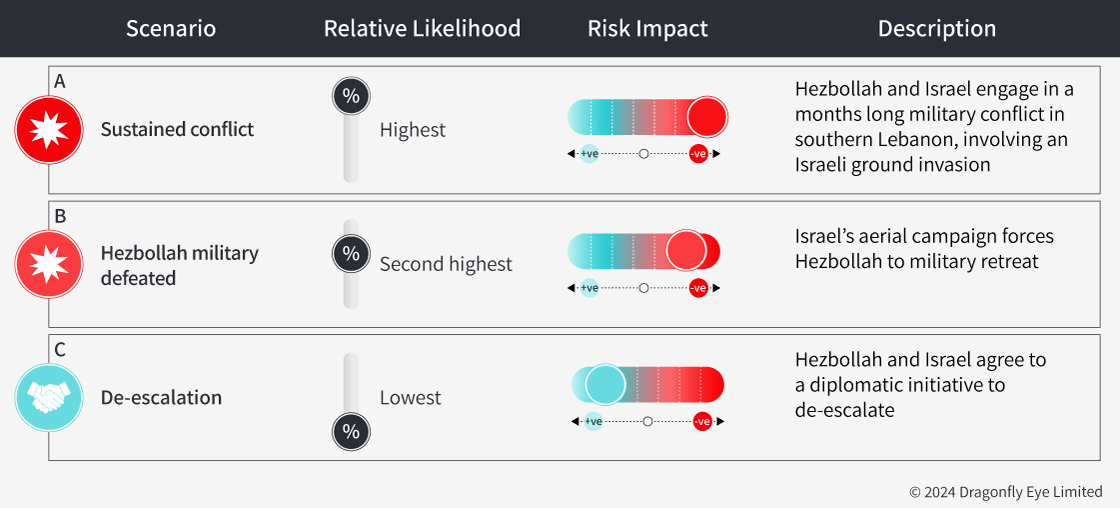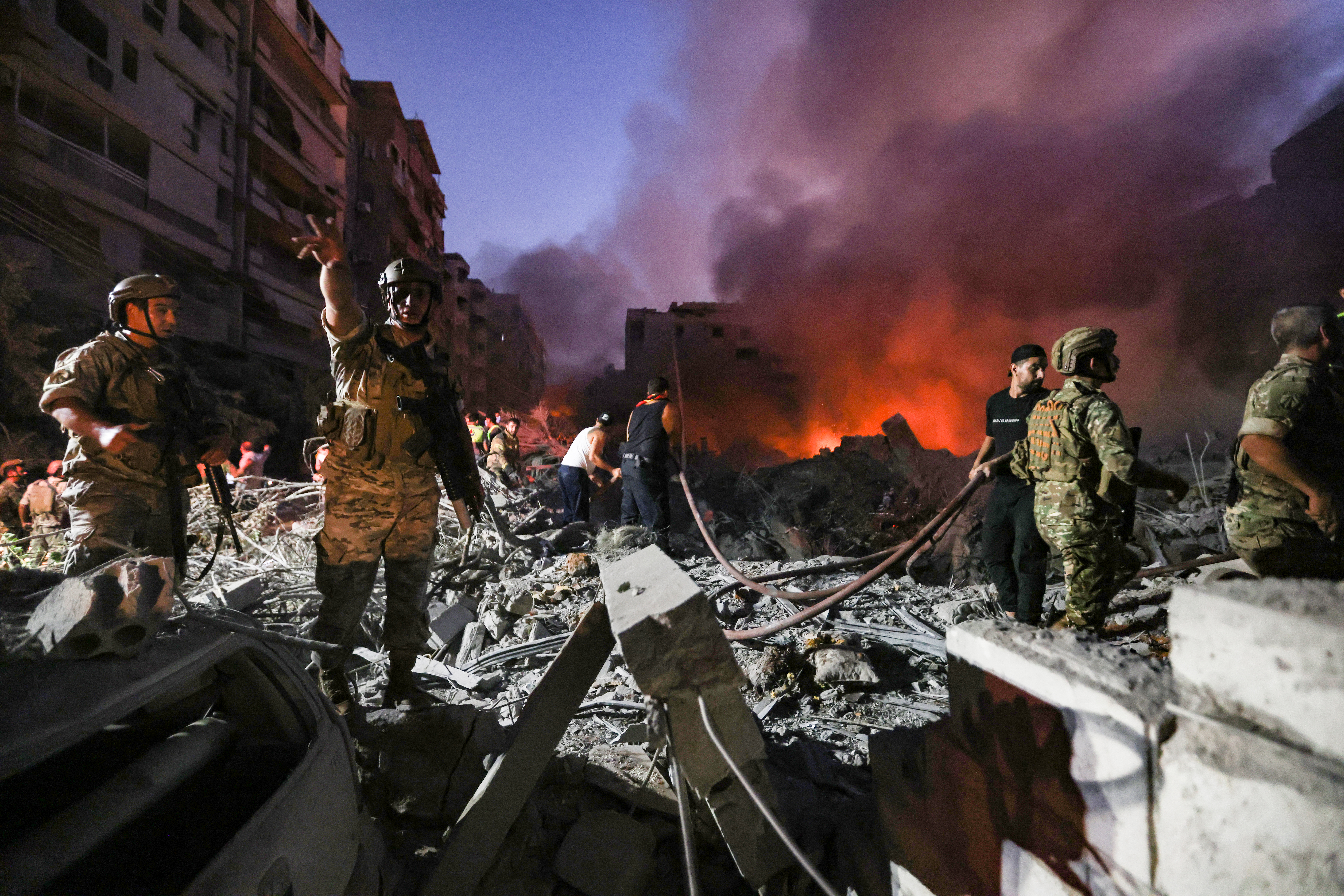A sustained military conflict between Israel and Hezbollah involving ground operations is likely to last for the next few months
This assessment was issued to clients of Dragonfly’s Security Intelligence & Analysis Service (SIAS) on 30 September 2024.
- Local and international media report today, 30 September, that Israel is preparing for the next phase of its military operation after two weeks of intense air strikes in Lebanon
- A total military defeat of Hezbollah remains unlikely in the near term (three months)
Clients have asked us where the current escalation between Israel and Hezbollah will be by the end of the year. We assess that a major military conflict, including ground operations between the two, is likely over this period. The Israeli military’s objective seems to be completely defeating Hezbollah to stop the group from launching missiles and rockets into Israel. With most of Hezbollah’s advanced weapons systems seemingly still operational, this means that the two sides will probably further escalate militarily, including an Israeli ground operation and Hezbollah firing deeper into Israel.
Israeli military focus on Hezbollah
Israel and Hezbollah are at war. Over the past two weeks, the Israeli military has intensified air strikes in southern and central Lebanon to target Hezbollah launch sites, as well as its leadership. On 27 September, the Israeli military conducted an operation that killed Hezbollah’s leader, Hassan Nasrallah. The Israeli leadership has formally stated that these air strikes are aimed at degrading Hezbollah’s military capabilities and ensuring the return home of Israelis displaced in the north. Still, its actions suggest that defeating – rather than degrading – the group is Israel’s aim.
The killing of Nasrallah in Lebanon has the potential to further expand the conflict in the region, in our assessment. Iran has vowed that all regional ‘resistance groups’ will retaliate against Israel. Pro-Iran groups in Iraq, Syria and Yemen have already claimed the launch of missiles towards Israel in recent days. The Israeli air force also targeted Houthis positions in Yemen on 29 September in response to the group launching long-range missiles towards Israeli territory.
Hezbollah seems to be on the backfoot; the group has incurred significant losses to its leadership and communications in the past few weeks. The group launched an average of 150 rockets and missiles a day since 18 September. But Israel says its military has killed all of Hezbollah’s military leadership and destroyed thousands of launch sites. And in the last two days, Hezbollah launches have dropped to around 40-50 a day. This is based on our monitoring of local media, as well as usually-reliable conflict tracker websites.
In light of these recent developments, we have conducted a near-term scenario (three months) analysis for the current escalation.
Hezbollah’s ability to fight and Israel’s will to eradicate the group
We have identified two key determinants for the trajectory of the current escalation; the ability of Hezbollah to launch cross-border strikes into Israel and Israel’s willingness to eradicate the group. Hezbollah still being able to launch missiles into Israel is the main reason Israel says it is intensifying air strikes. The extent to which Israel wants, and thinks it can, either to degrade or completely defeat the group militarily will also determine the scale of this war and possible avenues for de-escalation.
On current indications, we estimate Hezbollah will still be able to launch rockets into Israel even if Israel sustains air strikes at the current pace and intensity. US intelligence from 2021 suggests the group has around 150,000 rockets and missiles across Lebanon. And based on our analysis of patterns of Israel’s ongoing military operation, the group’s most advanced missile systems, such as ballistic missiles, have not been destroyed yet by the Israeli airforce. Iranian media outlets on 29 September stated that all Hezbollah military commanders have been already replaced.
We also estimate that rather than just degrading the group’s capabilities, Israel intends to completely eradicate the group militarily. In a sign of this, Israel has intensified air strikes in recent weeks, and eliminated all Hezbollah military leadership, as well as significantly damaged the group’s communications. The usually-reputable news outlet the Wall Street Journal reported on 30 September that the Israeli military has conducted small raids into southern Lebanon to damage the network of tunnels there.
Near term scenarios (three months)
Based on these key determinants and forecasts, we have outlined three scenarios to support planning for the rest of the year.

These revolve around several plausible trajectories of the current escalation and their implications for Israel, Lebanon, Gaza and the wider region.
Scenario A: Sustained military conflict between Israel and Hezbollah
Most probable scenario (50%)
The Israeli government authorises the military to launch a ground military offensive in southern Lebanon as Hezbollah continues to launch rockets into Israel. This leads to a sustained military conflict between the two lasting months. During such a conflict, Hezbollah launches several long-range precision missiles towards Israeli territory. In response, Israel targets and severely damages Lebanon’s critical infrastructure, such as the airport and key roads. Already-high to severe interstate conflicts risks across the region heighten further.
This scenario would have the following implications:
- Mass internal evacuations of large parts of southern and central Lebanon. And further evacuations from northern Israeli towns and cities
- Prolonged closures of Israeli and Lebanese airspace
- Pro-Iran groups in the region (Syria, Iraq, Yemen) increase the frequency of their attacks on Israel and the US from weekly to daily
- Israel conducts sporadic air strikes against pro-Iran groups in Syria and Yemen
- Direct Iranian attacks against Israel would become highly likely during the operation
- A risk of a major regional war would become very high, especially if Hezbollah is on the verge of being defeated militarily
- Hezbollah begins to target civilian centres in north and central Israel
- Displaced Israeli communities in the north are not able to immediately return home
- Foreign governments begin to evacuate citizens from Lebanon
- The terrorism threat remains elevated, between high and severe, in Israel and Lebanon
Indicators this scenario is becoming less likely:
- An international diplomatic initiative is agreed by both Hezbollah and Israel
- Hezbollah begins to withdraw fighters from the south amid heavy losses from Israeli air strikes
- The Israeli government collapses over internal disagreements on whether to further expand the conflict
- The US announces the end of military support for Israel
Points of no return
- The Israeli government issues an ultimatum to Hezbollah demanding the end of hostilities in a specific period of time
- The Israeli military conducts near-daily limited raids into southern Lebanon
*These are developments that we assess would make other scenarios only a remote possibility.
Scenario B: Hezbollah military defeated
Second most probable (40%)
Several weeks of intense Israeli aerial campaigns neutralise Hezbollah’s ability to launch missiles and rockets into Israel. Mounting domestic pressure on the group in Lebanon forces Hezbollah and its new leadership to accept a military retreat north of the Litani river. International pressure, as well as an opportunity to avoid a risky ground operation, allows Israel to view such a retreat as a victory and wind down their campaign in Lebanon. The Israeli military moves to significantly degrade or defeat other groups in the region, in particular in Syria and Yemen.
This scenario will have the following implications:
- Interstate conflict risks across the region remain elevated, from high to severe
- Israeli displaced communities in the north return home
- Israel shifts its focus on pro-Iran groups in the region, in Yemen and Syria
- Commercial flights over the Israeli and Lebanese airspace return to normal
Indicators this scenario is becoming more likely:
- Hezbollah is unable to mount daily attacks against Israel
- Large anti-Hezbollah protests take place across Lebanon to demand that the group retreat
Points of no return
- Hezbollah says it will seek a negotiated end to the conflict
Scenario C: De-escalation starts
Least probable scenario (10%)
After several weeks of intense fighting, potentially including ground operations, both Israel and Hezbollah seem to acknowledge that there is no military solution to the conflict. This is especially if Israel suffers hundreds of fatalities in the first phase of a ground operation. The prospect of displaced border communities in Israel and Lebanon not returning home for many more months leads the Israeli authorities and Hezbollah to accept a diplomatic initiative to end hostilities. Still, any de-escalation would probably only be temporary. The Israeli authorities refocus on confronting Hezbollah again within the next five years.
This scenario will have the following implications:
- Displaced border communities on both sides return home
- There are no longer closures of Israeli and Lebanese airspace
- Pro-Iran groups in the region (Syria, Iraq, Yemen) stop launching their attacks on Israel and the US
- The Iranian authorities publicly accept the diplomatic initiative
- A risk of a major regional war would become low
- Foreign governments ease travel advice to Lebanon
- The terrorism threat remains elevated, between high and severe in Israel and Lebanon
Indicators this scenario is becoming more likely:
- European countries submit formal proposals for deescalation to Israel and Lebanon
- Lebanese government deploys the Lebanese army to the south as a peacekeeping force
- Hezbollah and the Israeli authorities publicly support the initiative
- Hezbollah strongly signals it will comply with any diplomatic initiative to end hostilities
Points of no return
- Hezbollah and Israel reach an agreement to solve their dispute diplomatically
Image: Lebanese army soldiers gather over the rubble of a levelled buildings as people flight the flames, following Israeli air strikes in the Haret Hreik neighbourhood of Beirut’s southern suburbs on 27 September 2024. Photo by Ibrahim Amro/AFP via Getty Images.




